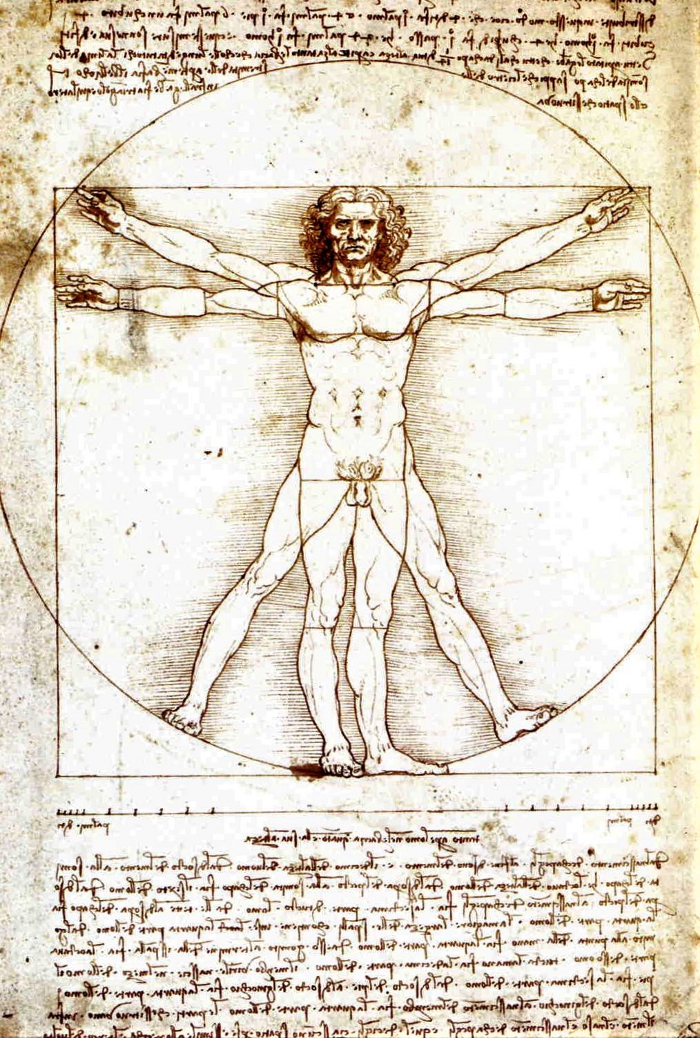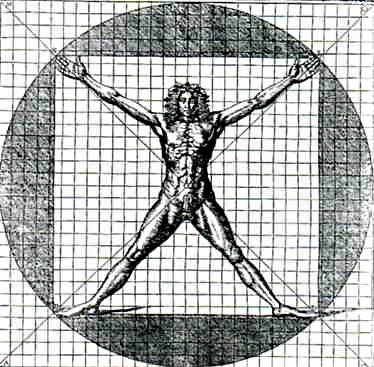The Vitruvian Man.
Leonardo da Vinci's study of the human form.
Leonardo's famous sketch was made as a study of the male human proportions. It was based on text written by the ancient Roman architect Vitruvius. This iconic image typifies the mix of science and art present in Leonardo's vision of the world. It is a prime example of a mind attempting to marry together the perfect proportions of the male form and link them to nature. He believed that the workings of the body are linked to the structure of the universe itself and this work is a fine example of Leonardo's constantly inquiring mind.
The multiple viewpoints seen in the drawing serve to illustrate that there are no universal set of proportions for the human body.
As Leonardo was working on the equestrian statue for Francesco Sforza, the Duke of Milan, he began to develop his ideas and studies on the proportions of the human body. He produced numerous studies of kneeling and sitting figures, comparing these measurements with the only known surviving study from antiquity, the Vitruvian Man.
Vitruvius was an architect and engineer who lived during the days of the 1st century BC Roman Empire. His writings included a treatise on architecture which included the measurements of the human body. Vitruvius stated that a man with his arms and legs outstretched would fit into the square and the circle geometrically and that the centre of the human body would be the navel.
Attempts to square the circle that is to fit the square neatly inside a circle and then fit the human body in proportion so that the arms and legs would simultaneously touch both the square and the circle did not work. This model necessitated the elongation of the hands and feet distorting the proportions to an unacceptable level.
 The Euro. (w)
The Euro. (w)Leonardo has corrected the errors in Vitruvius’s measurements based on his own findings. The square and the circle in Leonard’s drawing do not fit neatly into each other removing the need for the distortions of the Vitruvius model.
Vitruvius states that the centre of the body is the navel, but Leonardo's sketch shows that this depends on the position of the arms and legs, and when the figure is in the standing position, the centre of gravity is lower than the navel.
This worldwide icon is used in various forms in the modern world and is strongly associated with the medical profession. It has been used as a symbol for rock bands, NASA, and the Euro.
Many artists of the Renaissance studied the proportions of the human body using this knowledge in their work although none had dedicated so much thought and detailed attention to the subject as Leonardo. The woodcut by the Milanese surveyor Cesare Cesariano is a well-known failed attempt at realising the measurements of Vitruvius.
Note the elongated feet in Cesariano's woodcut. This was required to make the figure fit the Vitruvius measurements.
Personal opinion: -
Many theories abound about this work, secret meanings and a whole industry based on The da Vinci Code (a work of fiction but a great read) and astrological and mystical interpretations of the sketch. I confess I do not know if any of these are factual, but I prefer to view the work for what it is, a geometrical study that has stood the test of time. The drawing fascinates us and is the product of a Renaissance artist, scientist, mathematician, inventor, anatomist, and engineer.
Enjoy it, Leonardo, what a guy!
- Home
- Leonardo da Vinci
- Vitruvian Man


